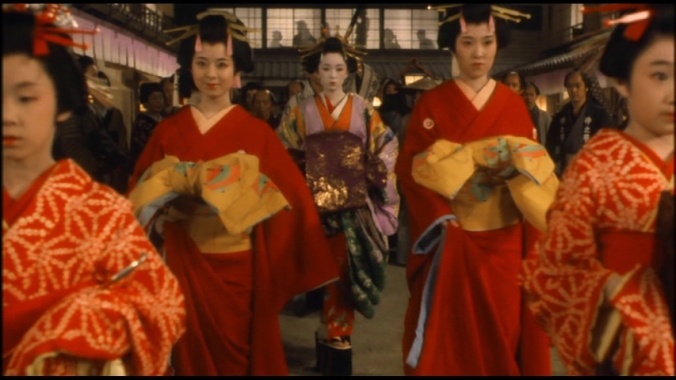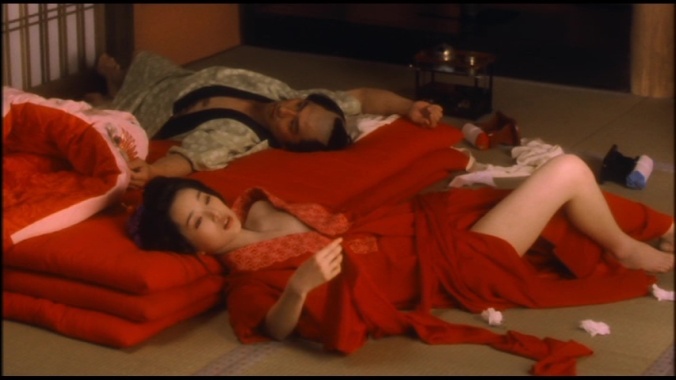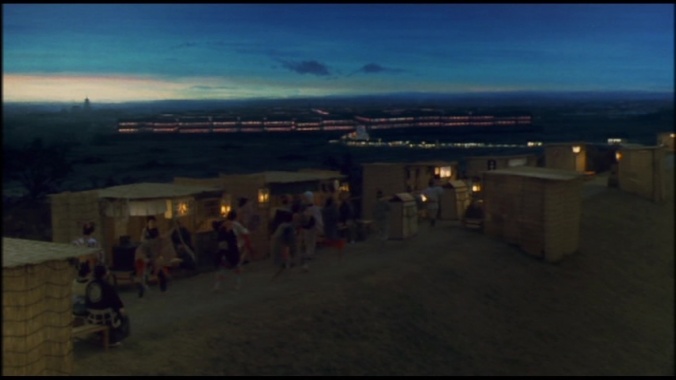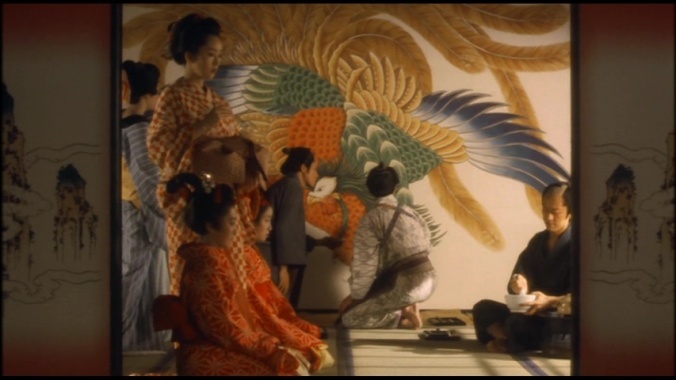The famous Japanese artist of the late 18th century known as Sharaku makes an ideal subject for a movie because absolute nothing is known about his life. His output has now been firmly dated by scholars to less than a year, but no one knows who he was before he became Sharaku, nor why he quit producing so suddenly. This allows Shinoda and his three screenwriters to go whole hog on a recreation of Edo’s Yoshiwara district and the Kabuki theater from which Sharaku drew his subjects, as well as developing a completely imaginary story of his life.
Sharaku himself often takes a back seat to the other characters and the spectacle, so often that we forget he is the subject of the movie, despite being played by Hiroyuki Sanada. He is an unnamed minor kabuki actor injured in a performance, leaving him with a permanent limp. He is taken in by a troupe of street performers led by Shima Iwashita, who gives him the name Tonbo. Then suddenly we switch to the story of the publisher Tsutaya (Frankie Sakai) whose business is threatened by the crackdown on public morals of the day. He and the novelist Santo Kyoden are sentenced to months in handcuffs and then his most popular artist Utamaro deserts him for another publisher. The crackdown has also severely affected the Kabuki, to which Tsutaya is connected in some financial way. Searching for someone to replace Utamaro and also make exciting new posters for the Kabuki, he tries Goro, who loves to sketch backstage, and then Tetsuzo, but their work is not what he wants. Tetsuzo stumbles on some drawings by Tonbo, who is then dragged into Tsutaya’s business, where he produces the striking portraits for which he is known today. Meanwhile he has fallen in love with the prostitute Hanasato, who eventually becomes an oiran and the mistress of Utamaro himself. Tonbo refuses to paint anymore and they eventually try to elope together, but she is chased down by the brothel’s owners and brought back. He last sees her years later as a common prostitute in a side alley.
Shinoda gives us some magnificent recreations of Kabuki performances at their most stilted and gaudy.
The street performers are extremely acrobatic, sometimes reproducing scenes from famous plays, sometimes just doing dances, all accompanied or narrated by Iwashita and her shamisen. Sometimes however they are early precursors of protection-money gangs who break into businesses and “perform” until someone pays them to go away. The street crowds are enormous and varied. The costumes for the stage and for the oirans on parade are beyond description.  The art shown is from the peak period of Japanese painting and printing. In addition to Sharaku’s work, we are treated to Utamaro’s female portraits, and later to some of his erotic paintings made for the other publisher (with key points blocked out by the film censors), and the recognizable small drawings of a dog tell us that Tetsuzo will eventually become known as Hokusai, though this is never clearly stated. This gives us a movie that is fascinating in parts and flamboyant in its spectacle but in which too much is really too much.
The art shown is from the peak period of Japanese painting and printing. In addition to Sharaku’s work, we are treated to Utamaro’s female portraits, and later to some of his erotic paintings made for the other publisher (with key points blocked out by the film censors), and the recognizable small drawings of a dog tell us that Tetsuzo will eventually become known as Hokusai, though this is never clearly stated. This gives us a movie that is fascinating in parts and flamboyant in its spectacle but in which too much is really too much.
The two human connections that matter are sketched rather than painted. Since Tonbo can not do acrobatics, Iwashita’s attachment to the younger man is probably love, but the only hint we see is her face while lying awake after another woman drags Tonbo out to another room for sex. Tonbo falls in love with Hanasato from afar and has only one blissful night with her when he is mistaken for a rich associate of Tsutaya. Utamaro sends them off with his blessing, because he senses a connection between them that has never actually been shown.
Utamaro sends them off with his blessing, because he senses a connection between them that has never actually been shown.
Sharaku’s paintings (and the prints made from them) are unique because they are portraits of the actors behind their makeup and costume. He is in fact an amateur who knows his subjects from his personal backstage experience before his injury, but since we don’t meet the actors in such circumstances we can not judge how accurate the art really is. For the time, his rawness makes his pictures powerful as well as unusual, but since he has no real interest in being a professional artist, it is not really a movie about the conflicts of the artist and public demand, such as seen in Edo Porn. He refuses to adjust to the demands of Tsutaya in part because he doesn’t have the skill as well as the interest, letting others finish his later pictures and then simply disappearing, or about the artist’s conflicts with the government, as in Mizoguchi’s Utamaro.
Unusually for a Shinoda movie, it does not seem to have really defined Iwashita’s character, so she seems wasted. Nor does it really define any depth to Tonbo. In many ways the movie is about Tsutaya, with Sakai in his last major role; only one brief cameo also for Shinoda would follow before his death in 1996. Utamaro (the always dependable Shiro Sano, who seemed to be in everything after he first appeared in 1988) actually comes off as more complex and oddly sympathetic than any of the principals – proud of his own value, seeking true artistic independence, both admiring and angry with Sharaku’s first paintings, so madly in love with Hanasato that he is willing to let her go for her own happiness, and last seen weeping uncontrollably beneath a cloth he has thrown over his head to hide his grief.
Sharaku is a movie that captures the constant and chaotic spectacle of the Yoshiwara as an island of light in a gray and darkened Edo,  of the Kabuki at its most insanely splendiferous, and of the oiran’s incredible costumes, with some striking painted screens as well as numerous paintings thrown in for good measure.
of the Kabuki at its most insanely splendiferous, and of the oiran’s incredible costumes, with some striking painted screens as well as numerous paintings thrown in for good measure.  It is not a world of the elegant simplicity usually associated with Japanese art and culture. There is always something eye-popping to look at, but it still seems never to get organized into the movie that, perhaps unfairly, we would hope for from such a cast and director.
It is not a world of the elegant simplicity usually associated with Japanese art and culture. There is always something eye-popping to look at, but it still seems never to get organized into the movie that, perhaps unfairly, we would hope for from such a cast and director.

